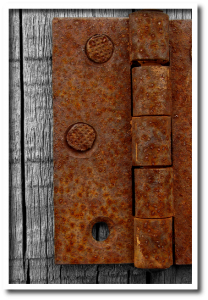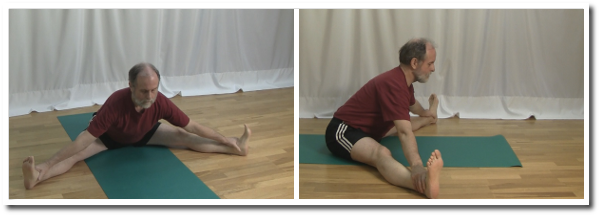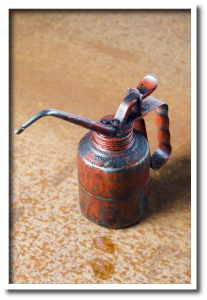Bob is attempting to shut the door on his shed but there is a problem. There is so much rust on the hinge that the door will hardly move. Bob pushes really hard and with a squeal the door reluctantly moves but it stops short of fully closed. The door hinge needs some oil, otherwise is not going to move any further.
Bob has a similar problem with Konasana, the wide leg forward fold yoga pose. Like the rusty hinge, his hips stop moving long before his torso comes to his mat. Like the shed door his hips need some oil.
What is Konasana
Konasana is a seated yoga posture where you lower your torso to the floor between your wide spread legs. This is an relatively easy pose to do because there is no binding or twisting involved.
The full Sanskrit name of the pose is Upavistha Konasana (pronounced oo-pah-VEESH-tah cone-AHS-anna) which means Seated Angle pose. The common English name for this pose is Wide Angle Seated Forward Fold because you fold forward with your legs spread wide apart.
Konasana strengthens the spine and works on stretching the muscles around your hip joint. It also stretches the abductor muscles and hamstrings in your legs. As you fold forward and down in the pose you are massaging and stimulating your abdominal organs as well.
First we look at how to do Konasana and then we look at using that oil can to improve the pose.
How to do Konasana
You start my sitting on the floor in Dandasana with your legs together straight out in front of you, your back tall with your shoulders over your hips and your hands resting on the floor beside your hips.
From here you inhale and spread your legs apart 90 degrees. Even if you can spread your legs further apart, stop at 90 degrees. This is the position of maximum benefit.
Now, as you exhale, tip your hips forward, bring your torso forward and bring your hands along your legs towards your feet.
Finally lower your torso towards the floor, hold the outside of your feet and gaze down your nose.
Hold here for several breaths.
Eventually your torso will be laying on your mat between your legs. In order for this to happen you need a lot of flexibility in your hips.
What is the challenge with your hips
Rather than getting his torso flat to the floor Bob discovers that his hips, like that old shed door, have stopped moving forward and that he is stuck with his torso up in the air.
Some people in this situation round their back in an attempt to get their head closer to the floor. Rounding your back is a bad thing for two reasons:
- It stresses your lower back
- It gives your hips a break
1. It stresses your lower back
When you round your back in an attempt to get your torso closer to the floor only the top portion of your torso is getting closer. Your lower back is rounding and you are putting a lot of stress into your lower back muscles.
The natural curve of your spine is gone and your vertebrae are at risk of being injured.
Finally when you round your back you are dropping your ribs towards your hips and compressing your abdominal organs. In this pose you should be lengthening your spine and creating space in your abdominal area.
2. It gives your hips a break
When you round your back to get closer to the floor you are taking the challenge away from your hips and moving it into your lower back. You allow your hips to stay where they are at as you work on flexing your back as you attempt to get your torso closer and closer to the floor. This is not the purpose of the pose.
The main purpose of this pose is to get your hips to be more flexible and get your entire torso to lay on the floor. To accomplish this you need to get your hips moving forward and down.
How to make your hips more flexible
There are three things Bob can do in this pose to get his hips more flexible.
- Lift your ribs
- Use your edge
- Use your breath
The most important thing Bob can do to protect his lower back and get his hips to start moving is to lift his ribs.
1. Lift your ribs
When you start to move your torso forward in Konasana, focus on your ribs. Lead with your ribs. Visualize that you are moving your bottom ribs forward rather than moving your shoulders and head down.
Moving of your ribs forward will keep your spine straight and prevent your lower back from rounding. Once you have your ribs moving forward it is time to focus on the next tool and find your edge.
2. Use your edge
As you move forward with your torso, bring your awareness to the stretching sensation in the muscles around your hips. Your Edge is that comfortable but challenging place in these stretching sensations. You move forward into the pose until the stretching sensations is the most that you can comfortably tolerate.
Once you have found your edge it is time to add in your breath.
3. Use your breath
To increase the flexibility in your hips you need to breathe. As you slowly inhale let your torso rise up slightly. As you exhale move your torso slowly forward again.
Pay attention to the stretching sensation in your hips and legs as you move your torso slightly back and forth. You are moving away from and towards your edge with each breath that you take. This movement away from and towards your edge will allow your muscles to eventually relax.
Gradually over many repetitions of doing the pose you will notice that when you exhale that your edge has moved and your torso is coming a little closer to your mat.
When you do all of these things you will notice that you have a new problem.
But I don’t fold as far forward
When you lift your ribs, use your breath and focus on your edge, you discover that your head is a lot further from your mat than it was before.
You should also notice that the stress is gone from your lower back muscles, your abdominal organs are not compressed and that your hips are complaining about your request to become more flexible.
This is a good thing. You are working on making your hips more flexible and protecting your lower back.
I feel more stretching in my hips
By lifting your ribs you have moved the focus of the pose from your lower back into your hips. Now instead of feeling stress in your lower back you feel stretching in your hips. This is where the stretching should be.
Eventually as you continue to focus on your hips your torso will come closer to the floor.
Summary
If Bob pushes too hard on that shed door he could tear the door off of its rusty hinges. In the same way if Bob pushes too hard in Konasana and rounds his back more and more he could injure his lower back muscles or his vertebrae.
To avoid this fate, Bob can apply work with his hips by lifting his ribs which will straighten his spine protecting his lower back from injury. Then he can use his edge and his breath to apply oil to his rusty hips and get them to start moving more freely.
Next Step
Check with your yoga teacher to make sure that you are protecting your lower back in Konasana and that you are using your edge to its maximum affect.
Additional Reading
To learn more about working with your hips in Konasana read Follow your Inner Budgie to get the most out of Konasana.
The article How to use the steam engine to find your edge helps you to use your breath with your edge.
To learn more about your breath and what it can tell you about your yoga pose read What your breath can tell you about your yoga pose






